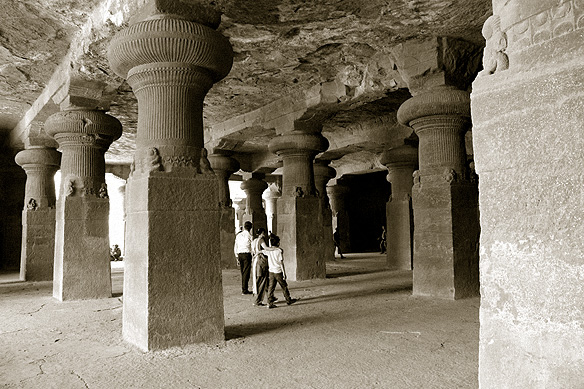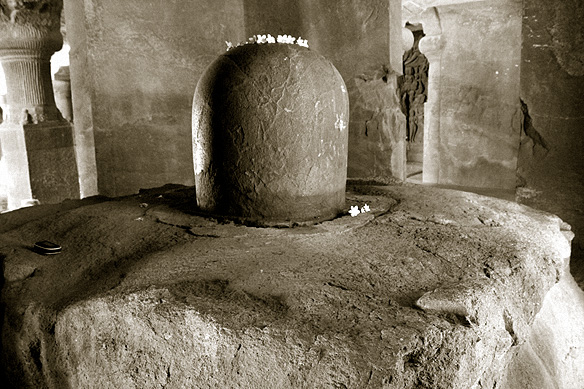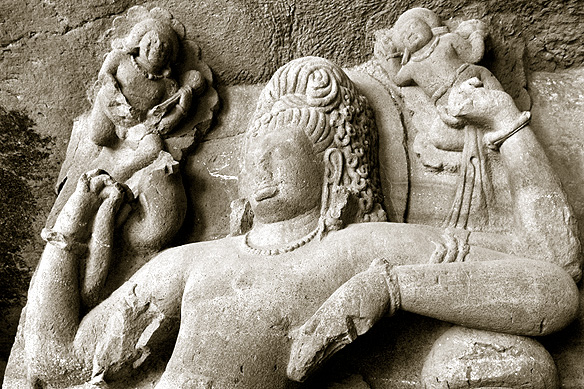
Trimurti or Sadashiva – The Creator, The Protector, The Destroyer
Some 10 kilometers into the Arabian Sea, off the coast of South Mumbai, is a verdant island covered with five 7th Century rock cut temples dedicated to the Shaiva Hindu sect. Known as Elephanta Island and originally as Gharapuri, literally meaning the ‘city of caves’, its basalt rock hewn temples pay homage to the various forms and legends of Shiva.
Every time I have set myself to ‘discover’ Mumbai, it has consistently included a visit to the Elephanta Caves. 25 years ago. And in my present chapter in this city too :). Thus, on one sun-drenched afternoon last month, I took myself off to the Gateway of India, to catch a ferry to this pocket of Mumbai’s history.
A Hindu place of worship till Portuguese rule in 1534, the island was renamed after a gigantic statue of an elephant which used to stand at the entrance, by the new rulers. Today, the carving is at Byculla.
The rock cut temples are a blend of Chalukyan architectural elements – colossal figures of divinities, guardians, and square pillars with capitals – combined with Gupta artistic features of mountains, clouds and female hairstyles, creating a timeless, mesmerizing display.
I walk through the porticoes and the first to hold my gaze is the 20 feet high Trimurti or three-headed Shiva across the cavern, at the very south end, representing the three essential aspects of Shiva – creation, protection, and destruction. As I wander amidst the basalt pillars a huge Shiva lingam in the central shrine meets me next. The stone walls, as if vying with each other, jump to life with carvings of Shiva, over 16 feet high. There is the Ardhanarisvara, half-man, half-woman representation of Shiva, and Gangadhara, denoting the river Ganges’ descent from Shiva’s matted locks, both resplendent in graceful detail.
Further tales of Shiva are recounted as I explore deeper – the Kalyanasundaramurti depicting Shiva’s marriage to the goddess Parvati, Andhakasuramardana the slaying of the demon Andhaka by Shiva, Shiva and Parvati on Mount Kailash (the abode of Shiva), and Ravananugraha portraying the demon-king Ravana shaking Kailash.
Every now and then the crowds would thin out and I would be alone in the company of the 1,300 year old reliefs. Some believe that these carvings are not man-made; there is no clear cut attribution to the carvings and various dynasties have been accredited by various historians. A designated UNESCO World Heritage Site, four of the five Hindu temples were extensively defaced by the Portuguese. The Great Cave or Cave 1, somehow survived and was restored in the 1970s.
A visit to the Elephanta Caves is often considered mandatory on any Mumbai darshan. It is not the only set of rock hewn cave temples in the city. There are also the Jogeshwari, Kanheri, Karle and Mandapeshwar caves. But the Elephanta caves are definitely the most majestic and beguiling.
Travel tips:
- Ferries leave from the Gateway of India
- Ticket: INR 150 return, Journey time: 1 hour one way, Monday closed
- Ferries to Elephanta Island: 9:00 am – 3:00 pm
Ferries from Elephanta Island: 12:00 pm – 5:30 pm - To view map of the Great Cave, click here

The Pillared Shiva Cave or the Great Cave

Shiva slaying Andhaka

The Shiva linga shrine with Dvarapalas at its doorways

The Shiva linga itself

Panel depicting Kalyanasundara: the divine marriage of Shiva and Parvati with Brahma, Vishnu, Indra and other divinities in attendance

Left: Shiva as Nataraja (cosmic dancer); Right: Leogriff figures guarding the inner sanctum, Shrine 2

The four armed doorkeeper


Lovely photographs!
LikeLike
Thank you Aradhana 🙂
LikeLike
Lovely article …………
LikeLike
Thank you 🙂
LikeLike
Love the tone of the images…feel bad that I have never been here…
LikeLike
Thank you 🙂 Gave a sepia effect to the images in Photoshop. Wanted to give them the sense of timelessness which I felt when I visited the caves. You just need half a day for the visit, but wait till the weather cools down ! 😀
LikeLike
Read your blogs. You write beautifully and I loved your pics. 🙂
LikeLike
Pingback: mumbai’s ancient rock-cut cave temples | rama arya's blog
Nice Article
Explore Elephanta Cave in 3D.
View 3D Sculpture of Elephanta Cave.
View here: https://reark.com/jewelvue_llp/elephanta-caves/models
LikeLiked by 1 person
Wow! These 3D models are fantastic, Ajay. Gives the sculptures, and our understanding of them, a whole new dimension. Thank you for sharing the link. Appreciated. 🙂
LikeLike
Pingback: classical india’s masterpiece: the ellora caves | rama arya's blog
Amazing Blog….
LikeLiked by 1 person
Thanks much for your kind words, Hrithik. 🙂 Welcome to my blog.
LikeLike